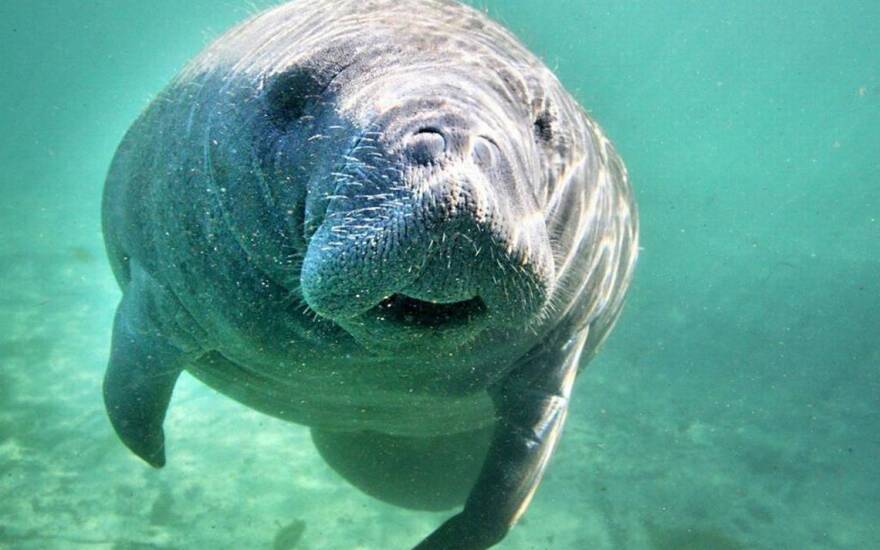TALLAHASSEE --- Wildlife officials said Wednesday an infusion of projects to improve water quality is a good start, as they seek to avoid a recurrence of large numbers of manatee deaths due to a lack of seagrass and degraded water in the Indian River Lagoon.
With state and federal wildlife officials planning to feed starving manatees in the coming months, members of the Florida Fish and Wildlife Conservation Commission pointed to a need for more long-term solutions, such as the $53 million that Gov. Ron DeSantis directed toward the lagoon in September.
“While we're dealing with the manatee mortality event, which is a symptom, we've got to also focus on the cure of water-quality improvement, especially in the Indian River Lagoon,” Fish and Wildlife Commission member Michael Sole, a former secretary of the Florida Department of Environmental Protection, said during a commission meeting in Destin.
Sole said DeSantis’ funding, which is expected to address 13 water issues involving the lagoon, “is essential to really solving some of this issue. But I think it's going to take more. I think it's going to take a continued focus on addressing that.”
Commission Chairman Rodney Barreto said the agency needs to put all resources, including the unconventional plan to feed manatees, into the effort, as “the eyes of the world are on us.”
The commission and the U.S. Fish and Wildlife Service have set up a Joint Incident Management Team to respond to the “unusual mortality event,” mostly along the state’s Atlantic coast. Through Dec. 3, Florida had 1,038 manatee deaths this year.
The record number of deaths, along with a single-year high in manatee rescues, have slowed in recent months as waters remained warm and the sea cows were able to expand their searches for food.
However, Gil McRae, director of the commission’s Fish and Wildlife Research Institute, said officials expect manatees to again congregate in the lagoon as water temperatures drop from the current 72 degrees to 68 degrees or lower in the coming months.
“Our concern is the combination of available forage not being there in some areas, especially in the central and northern Indian River Lagoon, and manatees aggregating in large numbers at warm water sites. That's where we run into trouble,” McRae said. “So, the longer it stays warmer, the more distributed the manatees will be. And that's likely to keep down rescues and mortalities for the short term. But we're preparing for January and February potentially being much colder.”
In 2017, manatees were upgraded from an “endangered” designation to “threatened” under the federal Endangered Species Act, with the U.S. Fish and Wildlife Service pointing to an increase in the manatee population and habitat improvements because of conservation efforts by Florida, Puerto Rico, Caribbean nations and public and private organizations.
The number of deaths this year is estimated to be about one-sixth of the population of manatees in the waters of the southeastern United States and Puerto Rico.
Travis Thompson, a conservationist and podcaster, asked the commission if the state was “near a carrying capacity in this state with manatees.”
“When we look back, historically, are there more manatees in the current incarnation, in the last five years or so? Did we reach a peak in manatee population?” Thompson said.
“We talked about water quality. Feeding manatees feels kind of funny to many folks in the conservation space,” Thompson continued. “Because it feels like we're putting a Band-Aid on something. And we're not treating the symptom. And I realize you guys are not in control of the symptom.”
The water quality funding from DeSantis in September is expected to eliminate more than 3,000 septic tanks and upgrade water-treatment facilities, while reducing the release of nitrogen and phosphorus into waterways.
As part of his proposed $99.7 billion budget for next fiscal year, DeSantis has asked for $125 million for a wastewater grant program, $50 million to meet nutrient-reduction goals and $3.8 million for the care and management of manatees. The proposed manatee funding includes $2.9 million to treat injured and distressed manatees.
In October, the commission said it would seek nearly $7 million from lawmakers as part of long-term goals to rebuild seagrass beds and wean manatees from artificial warm-water sites, including areas near power plants, that attract the sea cows in the winter. The 2022 legislative session starts Jan. 11 and will include passing a budget for the fiscal year that starts July 1.
Commissioner Gary Nicklaus said Wednesday that “we need to make sure that we focus on the cause, the upstream cause, because everything downstream happens from what happens upstream.”
The current year’s budget includes $8 million to improve manatee habitat and access to Florida’s natural springs. The commission has five years to use the money.
Copyright 2021 WLRN 91.3 FM. To see more, visit WLRN 91.3 FM. 9(MDAyMTYyMTU5MDEyOTc4NzE4ODNmYWEwYQ004))







